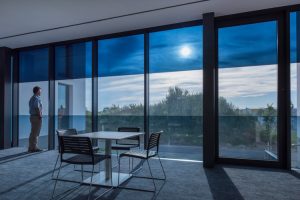*The glass industry in Mexico has a professional business platform, designed for the exchange of information, the presentation of products, services and technological innovation, including training sessions and lectures on current trends within the sector. Glasstech Mexico / Doors & Windows, will be held from July 9 to 11, 2024 at Expo Guadalajara. Please register as a trade visitor here: https://shorturl.at/J21b3
Electrochromic glass, new technology for architectural sustainability
(via inmobiliaire.com)
Electrochromic glass, also called smart glass, is a relatively new technology in the construction and architecture sector, which seeks to be a benchmark in terms of sustainability and energy savings.
According to OfficeDeco, it is a sheet that is installed on windows and transparent glass surfaces, which is able to change the opacity of the material and block the passage of light when activated through electrical stimuli.
In addition, it is able to reduce the need for active heating and cooling systems, following international certification goals such as LEED. Its adoption is expected to accelerate in the coming years as costs come down and performance improves.
An advanced, commercially available example of this application is Saint-Gobain’s SageGlass, capable of controlling its color, as well as light intensities and transmitted ultraviolet and infrared radiation.
The dynamic tinting of this glass is driven by an intelligent control system with sensors to respond to light conditions. Its appearance can also be controlled from a cell phone.
Its adoption is expected to accelerate in the coming years as costs come down and performance improves.


Electrochromic glass already used in luxury cars
Juan Bisquert, Professor of Applied Physics at the Department of Experimental Science at the Universitat Jaume I in Spain, explained that this technology is advancing in products such as displays, mirrors and roofs in luxury cars.
“Recently, an electrochromic composite was used in the Ferrari Superamerica, a model limited to 550 cars,” he explained.
The expert added that the most studied material is tungsten trioxide (WO3), which changes from transparent to navy blue with the insertion of protons or lithium ions.
“These materials exhibit a reversible change in their optical properties when oxidized or electrochemically reduced.
Also common is the use of tungsten that, when a voltage is applied, the ions change their oxidation state. This change modifies the light transmission and absorption of the glass, causing a bluish color.


